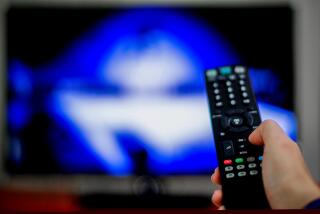Slice your cable bill with Apple TV
- Share via
Like moving furniture, rearranging household finances is an onerous task.
Cable television is one of the first places consumers look to save some cash. Movies, phone plans and eating out are next. And though your average tech enthusiast probably would prefer to sell a kidney than cut back Internet bandwidth, it’s often a victim of cost cutting too.
With a new baby at home, I needed to realign a few things financially (and move a whole lot of furniture). I wanted a convenient setup where I could watch movies, use the Internet and listen to my iTunes music in one place. In cutting back my premium cable TV and Internet package, I also had to make sure my wife could still watch her favorite shows.
My solution: Apple TV.
Newly launched in its second generation, Apple TV allows Internet users to stream TV shows, movies and music wirelessly via a router from their home computer to a widescreen TV without subscribing to a service. The device, about the size of a wallet, went on sale this month for $99 retail.
With access to programs from Fox and Disney from 99 cents an episode, and movie rentals from iTunes and Netflix, it’s easy to see how Apple TV could represent major savings on a typical cable package. But only up to a point. Sports fans, for example, will find it severely lacking in content. More about that later.
Apple Inc.’s first-generation set-top box was a bulky, unwieldy product that cost $230. Now the much cheaper, sleekly packaged, all-black box measures just a couple of inches across and about an inch deep, so it fits as well with an advanced audio-media setup as it does with Apple’s lineup of upscale products.
Its design and functionality are peerless. Plug the device into a TV with an HDMI cable (not included), power it up and it’s good to go. Within about 15 minutes, I boasted full mastery of its music and movie delivery. I had to upgrade my iTunes to the latest version so it could wirelessly broadcast to the box, but after that it delivered rich media content seamlessly. Though it connects wirelessly, there’s also a hard-wired Ethernet port.
Previously, I’d listened to iTunes on my desktop PC in my home office (now the baby’s room) and streamed Netflix and YouTube wirelessly to my living room TV through my Nintendo Wii console. That had to change, I decided, not least because streaming media through a Wii is cumbersome and there’s no high-definition playback. I also wanted to listen to my music collection on the sofa without having to connect my iPhone to my TV’s sound bar.
With Apple TV, all my media were available through my TV at the touch of a button on the uncomplicated remote control. If the three-button handset doesn’t appeal to tech heads, they can use their iPhone or iPod to control the device by downloading the relevant application.
Maybe this multi-device functionality will increase sales of a product that hasn’t replicated the sector-busting successes of the iPod or iPhone. Newly launched Google TV remains its most formidable competitor in an increasingly crowded online TV marketplace (and Google Inc. has partnered with more content distributors than Apple).
After I’d cut back my $200 a month cable bill — still using basic cable and free on-demand programming — Apple TV’s option to rent TV programs for a 30-day period was a real bonus. Movie rentals from iTunes and Netlix are generally available to watch for 24 or 48 hours, and, not being a DVR or TiVo user, I appreciated that I could pause and replay movies at my leisure (or after the baby stops crying).
It was only after I cut back my Internet speed that things didn’t move along so smoothly. In fact, movies and TV shows delivered through iTunes didn’t really move at all (whereas programming delivered by Netflix and YouTube weren’t affected all that badly). Of course, this was also because my cable provider offered only either 8-megabit or 1-megabit bandwidths. Handy, huh?
My cable provider won out this time, because after a couple of nights I jumped right back up to 8 megabits (for a $20 monthly premium).
I’d wager that anything under 3 megabits is likely to result in frustrating waits and blips during playback. Here, your money is well spent on a decent downloading speed.
So it’s not perfect. You can’t buy movies because the Apple TV device has no onboard storage capacity (so basically it’s rent only). It won’t connect to an old TV. Popular shows like “Project Runway” and “Top Chef” can be watched through iTunes, although there’s still no real solution for sports fans who are going to miss ESPN big time.
But I’m happy. The device will pay for itself in a couple of months, and I foresee saving about $50 a month. That’s a lot of diapers.






